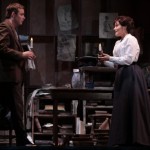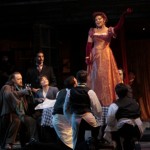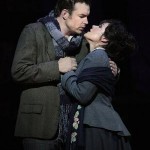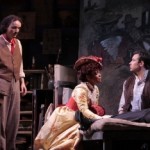Cast
Mimí: Ailyn Pérez
Rodolfo: Stephen Costello
Musetta: Janai Brugger
Marcello: Artur Rucinski
Colline: Robert Pomakov
Schaunard: Museop Kim
Benoit/Alcindoro: Philip Cokorinos
Conductor: Patrick Summers
Production: Herbert Ross
Director: Gregory A. Fortner
Set Designer: Gerard Howland
Costume Designer: Peter J. Hall
Additional Costumes Designed by: Jeannique Prospere
Lighting Designer: Daniel Ordower
Choreographer: Peggy Hickey
Of all the operas performed in LA this season, this was one that I knew I didn’t want to miss. Boheme is an opera that famously never fails to endear its audience, and I was tantalized by the thought of seeing the Rodolfo and Mimí of Stephen Costello and Ailyn Pérez, a real-life husband and wife whom some have dubbed “opera’s new love couple.” Furthermore, the production, originally staged in 1993 by the late film director Herbert Ross, is a mainstay of the LA Opera. I saw it back in 2004, starring Marco Berti and Ana Maria Martinez, and remembered it as magnificently beautiful, dramatically vivid and romantic, so I was eager to see it again. It didn’t disappoint, nor did any of the people in it! This Boheme performance was first-rate from beginning to end.
First of all, I’d like to express my love for the Dorothy Chandler Pavillion. The Music Center is such a beautiful space, an open, oasis-like spot in the middle of downtown urbania. At one end is the tall, modernistic square that is the Ahmanson Theatre, where the national tours of Broadway musicals generally play; in front of the Ahmanson stands the perfectly round Mark Taper Forum, which generally houses straight plays; next is a courtyard with an outdoor restaurant and an enormous, beautiful fountain; and last but not least is the massive, old-fashioned elegance of the Dorothy Chandler, home of opera and ballet. The inside is very pretty, nearly all white and gold, with gorgeous crystal chandeliers everywhere. The auditorium is four stories tall, with food and drinks sold on every floor and souvenirs sold in the lobby. Below the ground floor is a beautiful, deep reddish-brown walled room (leading to the restrooms and thus always crowded at intermission) that contains opera costumes on display, as well as mini models of sets. It’s probably a very typical city opera house and doesn’t begin to approach the size or elegance of the Met, but still, it’s my opera house and I adore it.
Before every performance, a “pre-opera” talk is given on the second floor by a music expert. Tonight’s talk was given by Prof. Mitchell Morris, whose outstanding series of opera classes I took at UCLA and whom I was very happy to see.
Now on to the performance itself:
Act I
The physical production was every bit as lovely as I remembered it. The set for Acts I and IV borrowed Franco Zeffirelli’s concept of an open-faced garret, situated below a rooftop against the Parisian skyline, but expanded on the idea. Here, the garret was only one section of the set. Below it we could see an outdoor flight of stairs, the wall and doors of the floor below where Benoit and his wife lived, and a wide rooftop terrace represented by the actual stage floor. In the distance could be seen a not-quite-finished Eiffel Tower. Thus the action was set circa 1889, roughly Puccini’s own time, rather than the traditional 1830s or ‘40s: a distinction reinforced by the excellent costumes designed by the late Peter J. Hall.
While at first it was a little disconcerting to see the singers confined to a small, removed space on a much bigger stage, it wasn’t long before I came to appreciate it. The shabby intimacy of garret living was certainly conveyed better than it would have been with full use of the floor. Besides, everything was beautifully constructed and the lighting was magnificently atmospheric. And how happy I was to hear that small, shabby space filled by strong, handsome voices, particularly coming from youthful, attractive bohemian figures!
Due to the set’s unique design, characters could be seen making their entrances well before they started singing. This was noteworthy when Mimí arrived. She appeared as Marcello, Schaunard and Colline were leaving the garret, noticed that Rodolfo was being left alone, and promptly blew out her own candle as an excuse to go in and meet him.
Stephen Costello’s voice I had heard described as having a Pavarotti-like quality, and it’s true. His tenor does contain some of that rich, luxurious shimmer. It’s a considerably darker instrument though. At first listen it was a voice that I more admired than loved. But soon I was won over by his deft handling of Puccini’s score. Besides, he was a handsome, boyish presence and a natural actor. I was concerned during “Che gelida manina” that he seemed to be cutting short so many notes, but then I realized he was probably doing it on purpose to make the aria sound conversational. The climax, in which he switched from conversation to poetry and described Mimí’s lovely eyes, was appropriately flowing and clarion.
I had similar feelings about Ailyn Perez’s Mimí. Her soprano wasn’t one I’d instantly describe as beautiful, but soon I came to appreciate its intensely creamy, lightly shaded warmth. Timbre-wise, I’d liken her to Victoria de los Angeles. Besides, she looked utterly adorable and, like Costello, was natural and believable onstage. Her aria, like his, was sung very conversationally, but with an appropriately sumptuous “Il primo sole é mio” climax. It was easy to believe in her quickly-blooming love for Rodolfo and his for her – understandably, since the two singers have gone through that process with each other in real life!
The staging of “O soave fanciulla” was quintessentially beautiful romance, with a deft touch of surrealism thrown in. When Rodolfo’s friends called up to him he went out onto the rooftop terrace to reply and Mimí followed him. Then, as their love duet began, the garret and other trappings of setting slowly moved backward and disappeared: the lovers were left alone, absorbed in each other, against a sky full of stars, an enormous full moon, and the rooftops of the city. I remembered that staging from 2004 and it was just as “dreamy” as I recalled. Though I have to admit, if I didn’t know that the production predated Moulin Rouge, I would have accused it of ripping off that movie’s “Your Song” sequence. I half expected the moon to grow a face and start singing in Placido Domingo’s voice!
Act II
The happiest of the opera’s four acts was a joy from start to finish. In this production, it began with the street vendors gathered in front of a brick wall covered in posters that evoked the popular art styles of late 19th century Paris. Then the wall, which was actually a scrim, rose up to reveal the Café Momus. The appearance of Parpignol provided even more eye-candy, with the colorfully dressed toy-vender juggling and doing magic tricks for the children.
Musetta made her entrance in an authentic 1880s motercar and proceeded to make an appropriately splashy impression. Janai Brugger made the character every bit as classy, funny, sexy and feisty as she should be, with a smoky yet pure, sweetly sensual voice that contrasted well with Ailyn Pérez’s more “romantic” instrument. The staging of her scena was slightly “all over the place,” but full of theatrical flair. First she got Marcello’s attention by throwing a plate from a second-story balcony, then came down onto the café’s red-curtained cabaret stage to sing her waltz aria, performing a G-rated striptease by removing her coat to reveal a sultry gown. I had to suspend disbelief when she came back “outdoors” to flirt with every man in sight wearing only that light gown, but I suppose that if any Boheme character is impervious to cold, it would be the resident hot-blooded seductress.
This is a good place to mention one of the big changes that this revival made from previous mountings of the Herbert Ross production: Musetta’s wardrobe, for some reason or other, has been completely redesigned. In the past, her Act II gown was a bright yellow and magenta number decked with roses. In this revival it was an orange and maroon creation. It was pretty, but I have to admit, I preferred the yellow gown I saw in 2004. But of course none of this detracted from Ms. Brugger’s performance, nor from the contribution of maestro Patrick Summers. For the first time in my experience with this opera, I was struck by the lovely, lyrical swelling of Musetta’s vocal line as she sees that Marcello’s resistance is breaking. I realized that just maybe that passage conveys not only triumph, but the love that Musetta truly feels for Marcello, loath though she is to show him much tenderness.
The act ended jubilantly with Musetta carried aloft amid the army parade, Marcello marching goofily at her side (while wearing her coat!), and Rodolfo and Mimí kissing at center stage while Alcindoro discovered the bill.
Act III
It’s funny… Puccini’s own favorite act of Bohéme was Act IV, and more than one review I’ve read from his contemporaries describes Act III as the weakest of the four… but nowadays Act III is almost universally hailed as the strongest and most moving of all! I’d like to debate the reason for that sometime. At any rate, the act had an appropriately moving effect here. The atmospherically snowy, misty set, with sky that at first was the dark gray and aquamarine blue of early dawn, then gradually grew brighter as the sun rose, earned applause from the audience. The inside of the tavern could be seen through a window, as could Marcello and Musetta’s bedroom on the floor above; Musetta’s reprise of her waltz aria was sung to Marcello as they canoodled in a state of semi-undress.
Ms. Pérez pulled out all the appropriate stops to squeeze the audience’s hearts, expertly conveying both Mimí’s anguish and her decline in health. I understand the LA Times reviewer’s criticism of her acting as “melodramatic,” but truth be told, she was no more, in fact less melodramatic than other Mimís I know (Renata Scotto, anyone?). And between the character’s illness and the loss of her lover, I think her role allows for a little melodrama. Costello’s Rodolfo was likewise convincingly distressed – he managed to finish the act without making me lose sympathy for the jealous poet, no mean feat considering how passionately Puccini depicts Mimí’s plight. Both continued to sing wonderfully.
The act’s entire final sequence was vividly choreographed. Throughout Mimí’s aria and the beginning of “Dunque proprio é finita,” she and Rodolfo avoided touching or even looking at each other much. But as their resolve to separate slowly weakened, they sat down side by side on a bench. Mimí took Rodolfo’s hand, and finally, as the orchestra swelled in its reprise of the “Addio, dolce svegliare” melody, she turned and put her arm around him. From that moment, it seemed, they knew they couldn’t part just yet.
Marcello and Musetta’s angry breakup took place in their bedroom rather than outside, and was very ugly on Marcello’s part. After catching Musetta flirting he roughly dragged her into the bedroom by her wrists, and proceeded to shout in her face, back her into corners, and finally pull all of her clothes out of her dresser, throw them at her feet along with her traveling bag, and then storm out, leaving the poor, overwhelmed girl alone to pack. It seems that either Herbert Ross or Gregory A. Fortner wanted to avoid the potentially sexist “Musetta as slut/Marcello as victim” impression, but went a bit too far in the opposite direction. This was the only part of the whole performance that left a bad taste in my mouth: I’m a feminist myself, but aren’t we supposed to like Marcello? But at least the painter semi-redeemed himself at the end. After Musetta finally left the inn, he reentered running after her, clearly having a change of heart, but found himself too late to stop her and leaned against a wall in despair.
Act IV
The final act, more than any of the others, was completely different from what I remember seeing back in 2004. Gregory A. Fortner seems to have created entirely new staging to replace Herbert Ross’s original. As I recall, in 2004, the Rodolfo/Marcello duet was staged traditionally, in the garret. This time, the two friends entered riding bicycles on the street, in front of the poster-covered wall from Act II. Then, as the duet began, the “wall” turned transparent and we were treated to “flashback” images, first of Mimí and Rodolfo together in the garret (Rodolfo played by a stand-in), and then Musetta in the position of her Act II striptease.
After the duet, the action shifted back to the garret, now in spring daylight, with climbing roses on Benoit’s wall and the distant Eiffel Tower looking more complete. This was no return to traditional staging, however. The bohemians had their dinner outside on the rooftop terrace and proceeded to play the opera’s last comic scene with plenty of joyful originality. Female tenants of the building, out hanging their laundry, were roped into joining the boys’ rowdy dance, and the scene culminated with Colline and Schaunard riding around the terrace on the two bicycles and playfully swinging brooms at each other.
One of my most vivid memories of the 2004 Bohéme was the unique staging of Mimí’s death. The entire scene was set out on the rooftop terrace in sunshine, with Mimí dying on a wicker chaise beside the roses. I assume the intent was to emphasize the ending’s bittersweet quality (Mimí dies, but at least she dies happy, Rodolfo is with her, Marcello and Musetta get back together, etc.). I remember enjoying the originality, but at the same time I found the contrast between the sunny imagery and the shadow of death a bit strange and jarring.
For this revival, director Fortner went back to tradition, much to the production’s advantage. Mimí died where she usually does, on the shabby little bed in the gloomy little garret. Thus emphasis was firmly on the tragedy of her fate, enhanced by the fact that over the course of the scene (in yet another touch of gorgeously atmospheric lighting), the sun went down and night slowly fell. By the time Mimí was gone, it was completely dark and the moon and stars were shining – a poignant reminder of the Act I love duet.
Ms. Peréz was once again spot-on in her portrait both of Mimí’s illness and of her fragile joy, while the grief of Costello’s Rodolfo seemed achingly real. As she slept he didn’t just sit by her side; he held her, stroking her shoulder and laying his head against it. That image distracted me slightly from Colline’s coat aria, though Robert Pomakov did sing it beautifully and received plenty of applause. Costello’s final outburst over Mimí’s body was outstanding as well, as he cradled her with racking sobs. Say what you will about “tastelessness,” but I love Rodolfos who sob uncontrollably over Mimí’s death; likewise I love Ewan McGregor’s passionate sobbing at the corresponding point in Moulin Rouge, deride it though some critics have. I find it incredibly raw, tragic and haunting. As the final notes faded, so did the stage lights, and the production’s final image was of the moon shining over the darkened rooftops.
I wish I had more to say about the conducting of Patrick Summers. Unfortunately, whenever I see a live performance, the visuals tend to distract me from what happens in the orchestra pit. But as far as I remember, his contribution was perfectly satisfying, with nuance, feeling, and no excessive melodrama.
The audience greeted the curtain calls with a rapturous standing ovation and I spotted a few eyes being wiped as the houselights came up. I wholeheartedly disagree with the LA Times’s lukewarm review of this production. True, it has a very traditional atmosphere (its innovations non-withstanding), but “traditional” doesn’t equal “dull”! This performance was traditional opera done outstandingly well. I’m overjoyed to have seen it!









michele serchuk
May 24th, 2012 at 21:05
You make me want to run to see this production. wow, I can see it all.
Eliza De Vries
May 25th, 2012 at 01:35
Incredibly sensual, deep, heartfelt observations..just love how you write..and I felt like I was sitting beside you through every scene..
Love your descriptions of the sets and voices in particular.
BRAVA Jordie.